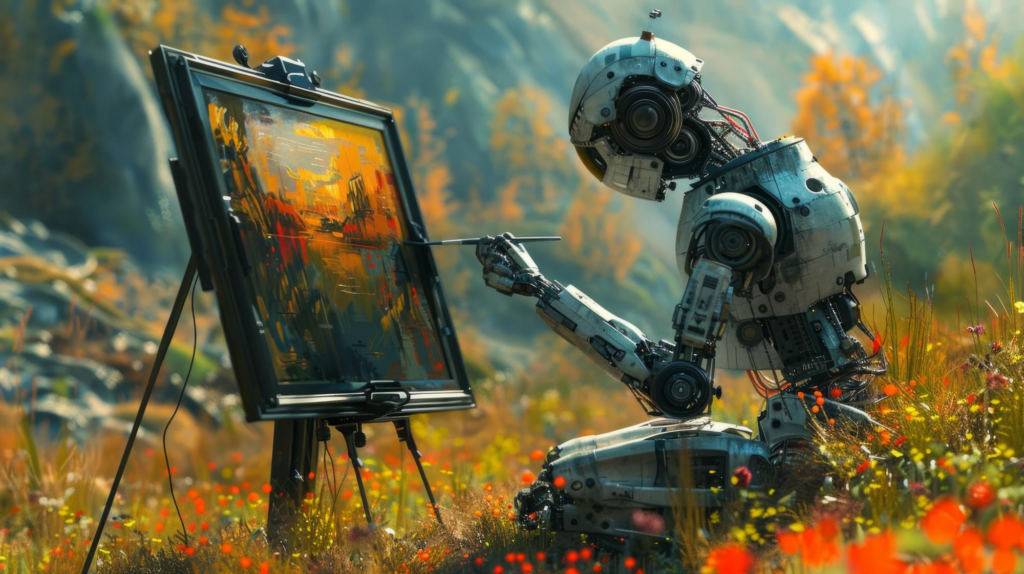
A canvas splattered with vibrant ideas, but instead of colours, there is algorithm. These algorithms dance with human imagination, creating campaigns that hit the mark, like a final stroke of brush on Picasso’s masterpiece.
Welcome to the new frontier of creative marketing, where Artificial Intelligence (AI) isn’t just a tool; it’s the muse, the collaborator, the game-changer.
At the intersection of tech and artistry, AI is rewriting the rules of how brands connect, captivate, and conquer. Buckle up because this is a revolution, and it’s global, bold, and wildly inspiring.
The Creative Renaissance Powered by AI
Marketing has long been based on storytelling, and AI is helping create stories with which people can truly live and interact. Crafting highly tailored messages and amazing pictures, AI will help design tomorrow.
McKinsey has reported that marketing companies using AI enjoy a rise in revenue of 10-20% and a cost decrease of about 30%. That’s more than data; it’s a massive change. Brands can now address you as an individual, thanks to AI’s instant processing of large sets of data. You get to have a coffee conversation with everyone around the globe at once.
Take personalization. Thanks to AI, Netflix’s recommendation engine doesn’t just propose shows; it arranges entertainment that can keep people watching for hours at a time.
By 2024, videos shown through their algorithm made up as much as 80% of user viewing, based on what their investor reports said, the company admitted. Imagine how helpful it would be for marketing if we could be this specific. Your online ad preferences can be customized based on your mood, the place you are or your previous Google search. You know you’ll be dying for a pumpkin spice latte before the season really starts.
AI doesn’t replace creativity; it amplifies it, giving wings to ideas that once stayed grounded.”
— David Ogilvy, Reimagined for the AI era
The Art of AI: From Pixels to Masterpieces
What comes to mind when you think of visuals? Tools like DALL·E 3 and Midjourney are making art that can compete with work from people. Within seconds, these platforms are capable of producing both unusual virtual worlds and exceptionally realistic product mockups.
According to a recent study at the University of Oxford, around two-thirds of consumers could not identify AI-made art in a blind test. That’s a serious reminder to act.
This gives huge brands quick, easy and flexible opportunities to develop visual content. Is a Tokyo billboard required by tomorrow? You’ll get your food before you can finish saying ‘Ramen.’
However, it’s more than just putting up nice pictures. In some ways, AI is able to tell stories. With these tools, your content can be very special: from blog posts to social media via lengthy brand manifestos. They check tone, style and people’s feelings towards the brand to create captivating words like a viral TikTok.
For instance, last year, Coca-Cola used AI in a campaign to create unique taglines for 50 marketplaces, boosting their engagement by 25%.
AI allows us to reach more people without losing what makes our brand interesting.
The Human-AI Dance: Collaboration, Not Competition
It’s time to get things straight now. AI won’t replace anyone in creative work or make creatives disappear. It’s meant to help you, not take your place.
See it like a sous-chef, doing the prep work to give the main chef time to work their magic.
Ed Catmull writes in Creativity, Inc., “Both art and technology stimulate and influence one another.”
Thanks to AI, the marketers can focus on creative elements, while AI tackles manual work, analyzing results, testing and grouping audience sections.
We see AI at Cr8ive Control as a real hype man. We use it to quickly bring a client’s concept to life in campaigns worldwide. We’re not playing by guesswork; analytics from AI helps us target with pinpoint accuracy.
A 2022 Harvard Business Review finding shows that combining AI with human judgment leads to campaigns that are 15% more effective than those driven only by AI or humans. That’s where people and technology connect in just the right way.
Everything has Legal Consequences, too.
When you have a lot of power, you must act responsibly. Applying AI in marketing isn’t open to anyone without experience. There are new laws in place, so marketers should be ready for them. As part of the 2024 EU Artificial Intelligence Act, companies are required to spell out when ad content is created using AI.
Fines for failing to comply can go as high as €30 million or 6% of the annual income. In the U.S., the FTC requires companies using AI for endorsements to clearly identify them so there is no chance for misleading consumers.
Next, we have copyright. Computers that learn from large collections of information may sometimes produce work that violates others’ material. Bringing legal action to an AI platform in 2024, Getty Images said its copyrighted images had been used improperly, setting off a worldwide debate.
To avoid trouble with the law, marketers need to check that the information generated by AI is unique.
It’s a smart move to work with licensed data and check everything with tools such as Copyscape.
Keeping Things Ethical with AI
Ethics matter. AI keeps ads from being shown to a lot of unnecessary viewers, yet it cannot guarantee they are always reaching the correct ones. Cambridge Analytica showed in 2018 how dangerous it is to use personalization on a large scale. Customers now shy away from businesses that seem to act dishonestly, as 73% said so in the latest 2024 Edelman Trust Barometer.
It is important to approach AI carefully to make sure campaigns show respect for both privacy and cultural values. Sometimes, when cultural context is not considered, AI translations fail. “Come alive with the Pepsi generation” was translated as “Pepsi resurrects your ancestors” in a country that didn’t recognize how the English idiom was meant.
People trust a business that is authentic. While AI examines people’s feelings about a topic, humans should control what the text says. AI can be used to design advertisements for global sales in Seoul, São Paulo and Sydney, but it is still humans who help make sure the ads don’t upset the audience.
AI as Your Brainstormer
Here’s where it gets interesting.
Artificial intelligence is efficient and fun.
Imagine brainstorming with a tool that spits out 100 campaign ideas in a minute. Or using AI to create a virtual influencer who hosts a live Q&A on Instagram.
In 2024, virtual influencer Lil Miquela, powered by AI, gained 3 million followers and partnered with brands like Prada. That’s something beyond marketing; it’s a cultural phenomenon.
AI also gamifies campaigns. Nike’s 2023 “Run Your Way” campaign used AI to create personalized running challenges based on users’ fitness data, boosting app engagement by 40%. It’s interactive, it’s fresh, it’s you. And for marketers, AI’s predictive models can forecast trends before they blow up.
The Global Stage: AI’s Worldwide Impact
Marketing works without boundaries, and AI opens the door. It helps people speak the same language, follows regional customs and executes campaigns in many time zones.
The Forrester report from 2024 shows that about 60% of global companies will start using AI for localization in real-time by 2026.
Just visualize a single marketing campaign that fits each crowd’s needs in Dubai, Dublin and Delhi. AI means this happens as it studies changes locally, deciphers hip slang and keeps up with emojis to keep the game updated.
For a global agency like ours, this is gold. We can craft campaigns that feel local, no matter where you are. AI’s translation tools, like DeepL Translate, ensure messages don’t just translate; they connect. And with 5G and cloud computing, AI’s speed means we can launch a campaign in hours, not weeks.
The Future of Art & Algorithm
AI is evolving fast. By 2030, Gartner predicts 80% of creative content will involve AI, from virtual reality ads to AI-composed jingles. But the heart of marketing remains human.
As Seth Godin says in This Is Marketing, “People don’t buy goods and services. They buy relations, stories, and magic.”
AI can do amazing things, but only people can power it.
What’s the next step for education? Holographic billboards? What does AI have to do with scent marketing? Campaigns that respond to your body’s movements? We can do so much and our creativity holds back nothing.
At Cr8ive Control, we are not just influenced by this trend; we are embracing it full of happiness and excitement.
Wrapping It Up for The Artistry of Tomorrow
AI is reshaping marketing and redefining what’s possible. It’s the spark that turns ideas into movements, the tool that makes it feel personal.
But, it’s not about technology for technology’s sake. It’s about connection, creativity, and courage.
So, let’s embrace the chaos, dance with the algorithms, and create campaigns that sell and soar.

